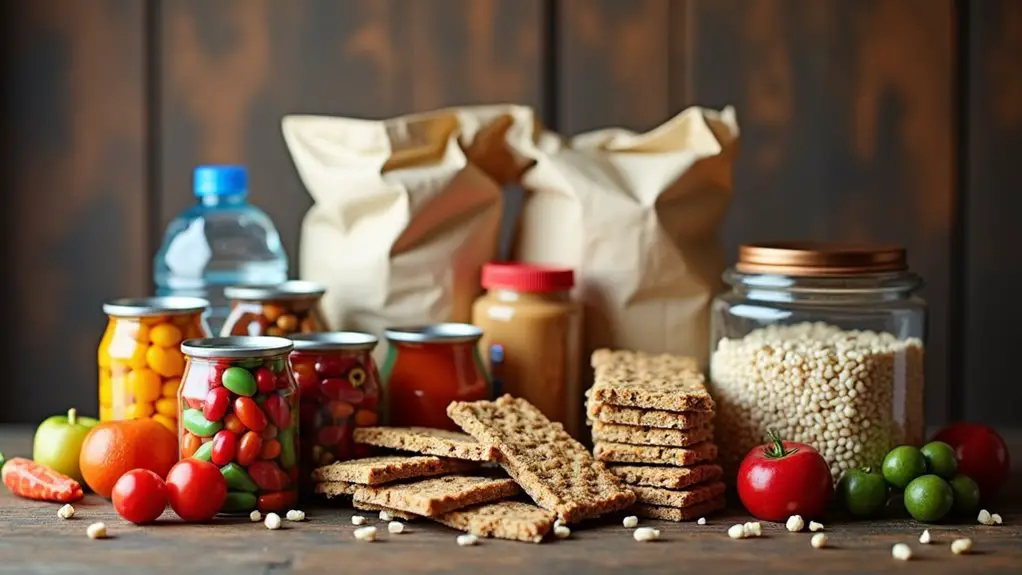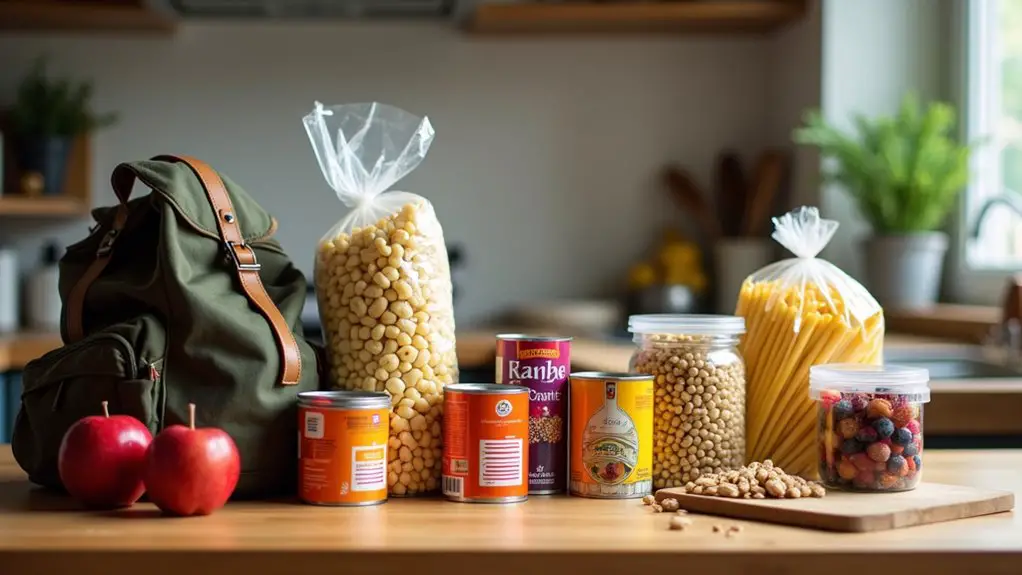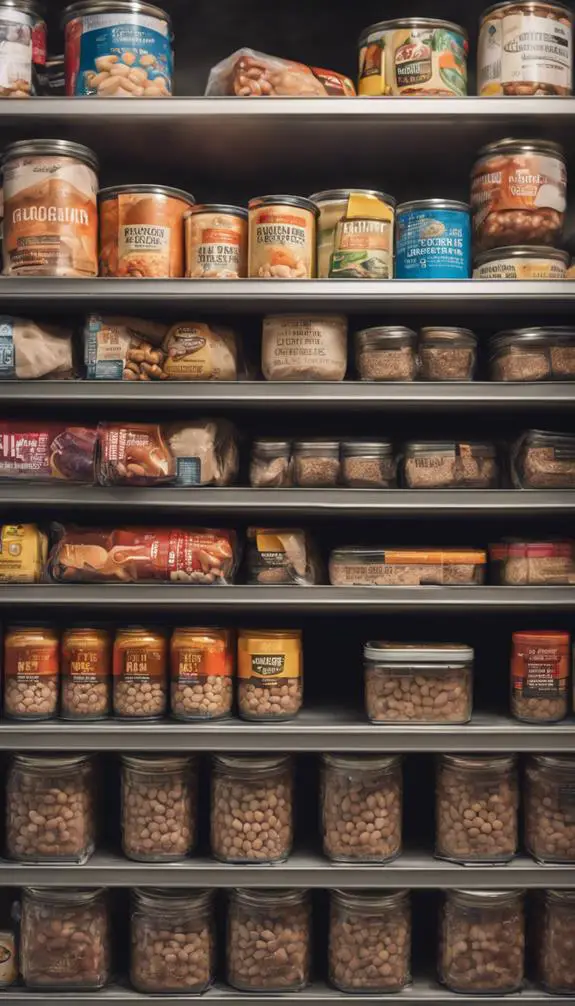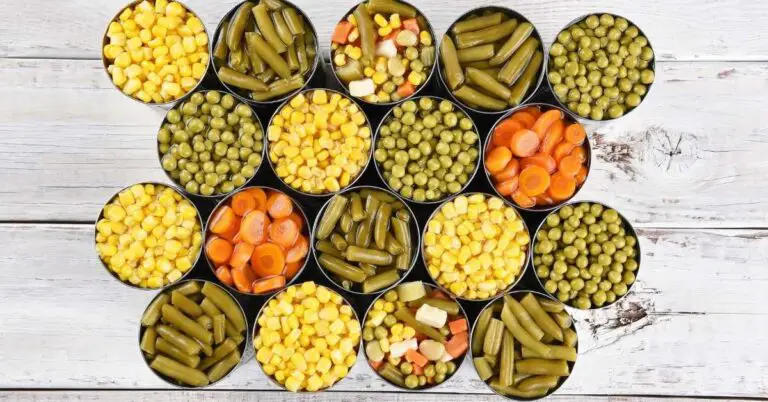When it comes to preparing a three-day emergency food supply, you need to focus on non-perishable items that can sustain your family. Think about the essentials: canned goods, freeze-dried meals, and quick snacks. It’s not just about quantity; variety matters too. You’ll want to take into account everyone’s preferences to help maintain morale during tough times. But what specific items should you include to guarantee nutritional balance? Let’s explore that next.
Summary
- A 3-day emergency food supply should include non-perishable items like canned beans, vegetables, and soups for balanced nutrition.
- Include freeze-dried meals that are lightweight and require minimal preparation, ensuring easy cooking during emergencies.
- Snacks like nuts, granola bars, and dried fruits provide quick energy boosts and help meet caloric needs.
- Organize food items by expiration dates and label containers for easy access and identification during a crisis.
- Plan meals based on family preferences to enhance satisfaction and ensure everyone is willing to eat the emergency food.
Essential Food Items for a 3-Day Emergency Supply

When preparing a 3-day emergency food supply, it’s essential to choose items that are nutritious, non-perishable, and easy to prepare.
Start with canned goods, as they’re readily available and packed with essential nutrients. Look for options like beans, vegetables, and soups that provide both sustenance and variety.
Next, consider freeze-dried meals; these offer a lightweight, long-lasting solution that requires minimal preparation—just add water and enjoy.
Don’t forget to include snacks like nuts or granola bars for quick energy boosts.
By selecting these items, you guarantee that you have nourishing food on hand during emergencies without unnecessary complications.
Tips for Storing and Rotating Emergency Food
Although it might seem straightforward, storing and rotating your emergency food supply requires careful planning to guarantee it stays fresh and ready for use.
Start by designating a cool, dark, and dry space for your food storage. Organize items by expiration dates, placing newer items at the back and older ones at the front.
Create rotation schedules to regularly check and replace expired items, ensuring your supply remains viable. Use clear containers or labels to identify products easily.
Don’t forget to include a variety of foods to meet nutritional needs. Regularly review your stock, adjusting quantities based on family size and preferences.
With these tips, you’ll enjoy peace of mind knowing you’re prepared for any emergency.
Preparing Your Family for an Emergency Food Supply

Having a well-organized food supply is just the start; preparing your family for an emergency is equally important.
Begin by discussing family food preferences to guarantee everyone feels satisfied during a crisis. It’s vital that your emergency meal planning reflects what your family enjoys eating. This not only boosts morale but encourages everyone to participate in meal preparation.
Create a simple menu using non-perishable items and involve your family in the process. Make certain everyone knows where the emergency food is stored and how to access it.
Regularly practice using the supplies through mock drills to build familiarity and confidence. Empower your family by teaching them about nutrition and the importance of staying prepared.
FAQs
How Do I Choose the Right Container for My Emergency Food Supply?
When choosing the right container for your emergency food supply, consider the container materials carefully. Airtight options like plastic or glass prevent moisture and pests.
For easy transport, lightweight options like mylar bags or durable plastic bins work well. Think about your storage options too; stacking bins can save space, while vacuum-sealed bags maximize freshness.
Whatever you choose, make certain it’s easy to access and protects your food from environmental factors.
Can I Include Pet Food in My Emergency Supply?
Absolutely, you can include pet food in your emergency supply!
When considering pet food, think about your pet’s dietary needs and how long it lasts. Opt for high-quality, shelf-stable options that won’t spoil quickly.
Store it alongside your emergency food storage in a cool, dry place. Don’t forget to rotate the supplies regularly to keep them fresh.
Your furry friend deserves to be cared for during emergencies just as much as you do!
What Are the Best Foods for Children in an Emergency Supply?
When preparing an emergency supply for kids, focus on nutritional balance and kid-friendly options. Include items like granola bars, canned fruits, and peanut butter, ensuring they’re easy to eat and appealing.
Consider shelf-stable milk or fortified drinks for added nutrients. Don’t forget snacks like trail mix or crackers to keep their spirits up.
How Do I Identify Food Allergies in My Family for Emergency Planning?
To identify food allergies in your family, start with open family discussions about any allergy symptoms like hives, stomachaches, or breathing difficulties.
Keep a food diary to track what everyone eats and any reactions that follow.
Consult a healthcare professional for guidance on testing and diagnosis.
When planning for emergencies, make certain you have allergy-safe options available, so everyone can stay safe and nourished, no matter the situation.
What Should I Do With Expired Food in My Emergency Supply?
When you find expired food in your emergency supply, it’s essential to handle it properly. Start by checking for any signs of spoilage.
For safe expired food disposal, follow local guidelines—some areas have composting or special waste disposal services.
Don’t forget to practice emergency supply rotation; regularly review and replace outdated items to guarantee you’re always prepared.
Keeping your supplies fresh gives you peace of mind and the freedom to face unexpected situations confidently.
Conclusion
Having a well-planned three-day emergency food supply can make a significant difference in a crisis. By including a variety of non-perishable items, you guarantee your family gets the nutrition they need while maintaining morale. Remember to store your food correctly and rotate it regularly to keep it fresh. Preparing in advance not only offers peace of mind but also empowers you to face emergencies with confidence. Stay ready, stay safe, and don’t overlook this essential preparation.


